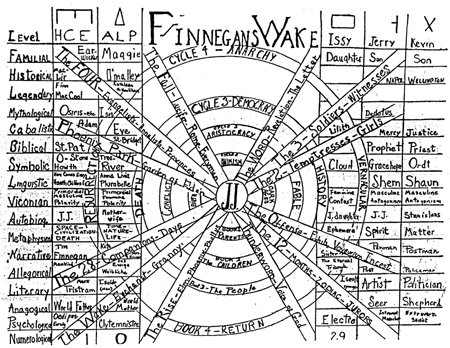Richard Kostelanetz calls the image above, from László Moholy-Nagy’s “Vision in Motion,” “a masterpiece of graphic literary criticism.”
Not only did he understand Joyce’s extraordinary work better than anyone else writing at that time, but Moholy also provided a chart that, as it uses his favorite visual forms of the rectangular grid and circles, remains to this day the most succinct (and inspired) presentation of the Joycean technique of multiple references.
More on Moholy-Nagy: A few photos of his “Vision in Motion” book at Flickr. “The fiery stimulator” is a Guardian profile of Moholy-Nagy which calls him “the most inventive and engaging of all the Bauhaus artists.”


Matt
on 04 Oct 07Cool stuff. As a fan of Joyce and, perhaps ironically, clear communication, I love the model.
Jesse
on 04 Oct 07I’ve seen better at Lime Tree. It’s a diagram of seasonal recursion in a brief epic by, if I recall, the poet Shelley.
I blogger searched, alack; that’ll do, pig.
\Jess
Jesse
on 04 Oct 07Besides, that shit looks like it was written by some monk in Jarrow.
But it **is cool that Chicago is the new New York.
For real. I’m there.
Jesse
on 04 Oct 07God, that’s ugly. Fuck motherfucking Finnegan’s wake already. Leave that to the pro’s. Let’s start with Araby, fellas.
Nick
on 04 Oct 07I actually picked up Finnigan’s Wake a few days ago at a book sale for $1. As someone who has only a passing interest in literature, it’s almost entirely unapprochable to me. Does anyone have any good references for getting through it, because it really is nothing like The Dubliners.
Eric Anderson
on 04 Oct 07Am I the only one that thinks that image is so crazy I cannot make heads or tails of it? You say it is “succinct” but I’ll have to take you word for it because clarity is greatly lacking.
Justin Reese
on 04 Oct 07@Eric: In this case “succinct” is relative to the book itself.
Tom
on 05 Oct 07Looks like a map of Washington D.C.
Skott Klebe
on 05 Oct 07So how did you come across this Moholy-Nagy, Matt? Just through reading Kostelanetz’ blog? Or were you looking for it?
Finnegans Wake IS really tough, especially the first ten or so pages. He worked as hard on most of his sentences as some novelists work on whole books. I’m sure Joyce’s mental model of Finnegans Wake was even more complex than this.
Dubliners is his most accessible stuff, but if you were going to read only one Dubliner story, it should be The Dead.
Other than typography (no quotation marks) Portrait of the Artist as a Young Man is quite accessible, as well.
The first time through Ulysses, it’s very helpful to have a companion – Don Gifford’s is fine. Finnegans Wake, though – he spent decades writing it, and expected his readers to spend the same effort reading it. I’ve spent decades not reading it, which doesn’t amount to the same thing. :)
peacay
on 05 Oct 07There is no apostrophe in Finnegans. Wake up!
Dave Davis
on 08 Oct 07While this particular diagram is far from his greatest work, it’s representative of Moholy’s method and thought process. He was far ahead of his time, already conceiving the structure and outlines of our present network/data age, and the end of agro/industrialism. Like many of his contemporaries, his experience with 2 world wars left him convinced that the status quo was unsustainable.
I teach many of his concepts and techniques in a digital design program. He anticipated media where narrative and form were constructed on the fly, by design or accident, and considered structure to support “virtual” constructs using rule-based design. His films anticipated reality television, for instance, and like much of his art and writing, were difficult to appreciate and experience with the linear technology and media of his day. One of his exercises discussed in Vision in Motion, which he termed a “Word Modulation” technique, was devised in the 1940s. While Moholy worked through the process, his direction and remarks point directly to “mash ups” and sampler-based sound design, which were difficult to do at all, and impossible to do as well as a modern cut-up artist like RX or DJ Shadow.
While Vision in Motion is certainly his most holistic, articulated perspective, his first book The New Vision has more energy, and is a better read. It has just been reissued, along with a great essay in a single edition. Amazing man, worth a long, hard look more than 50 years after his death.
This discussion is closed.